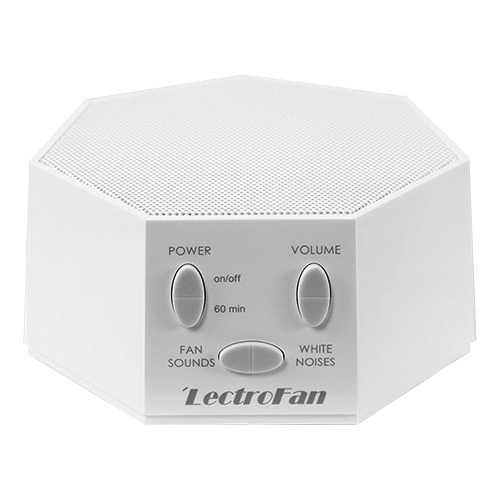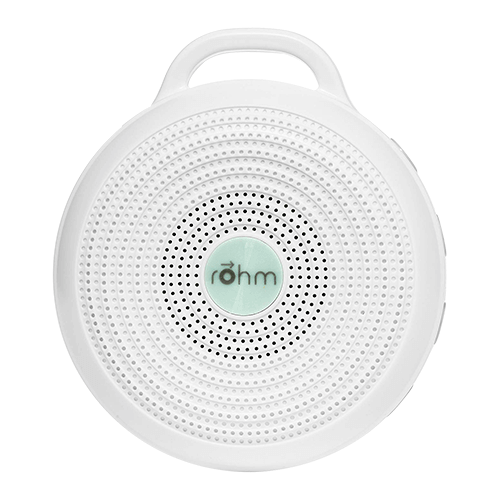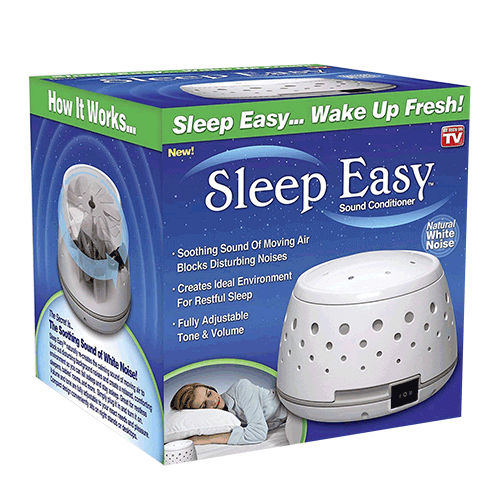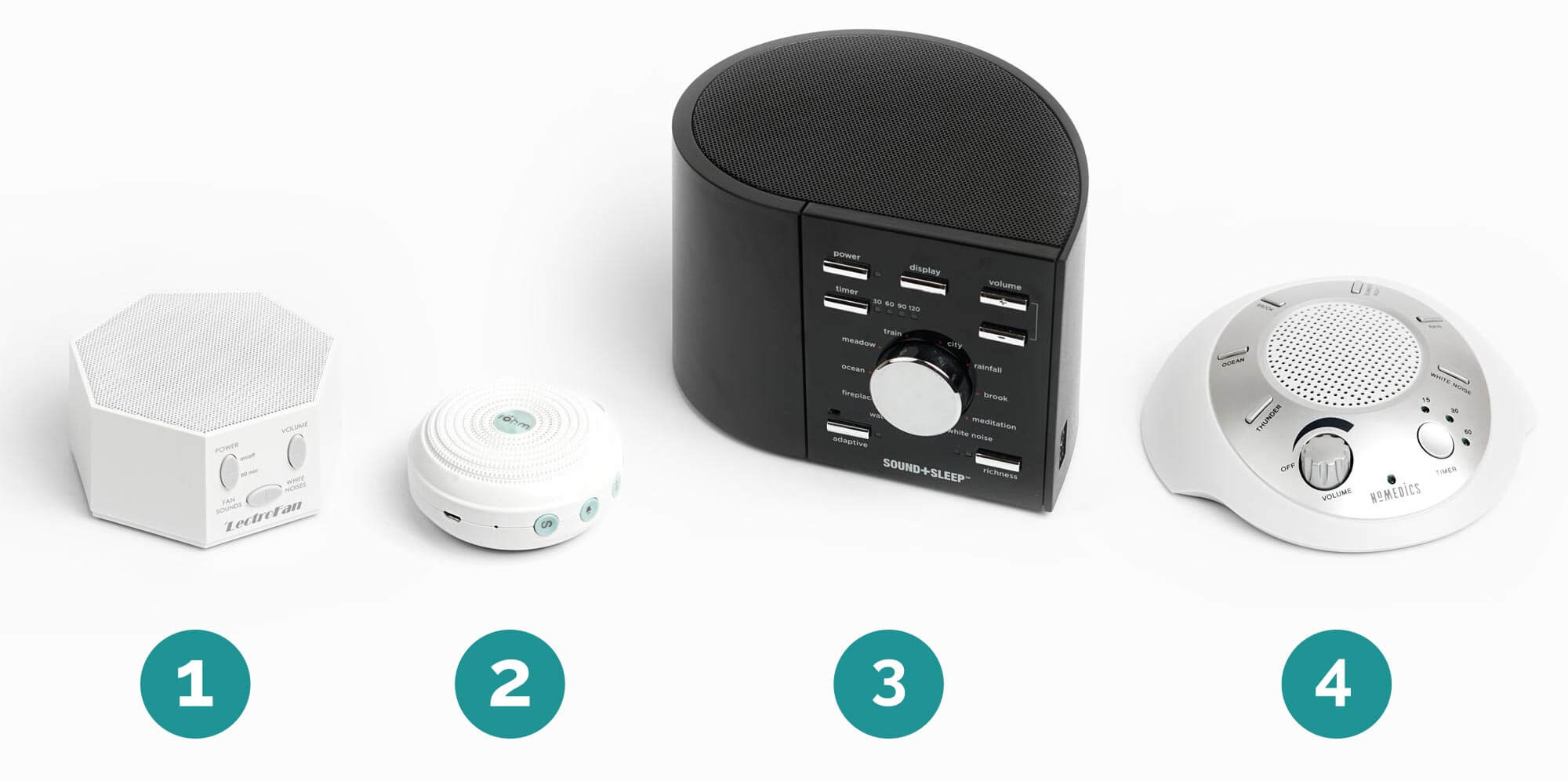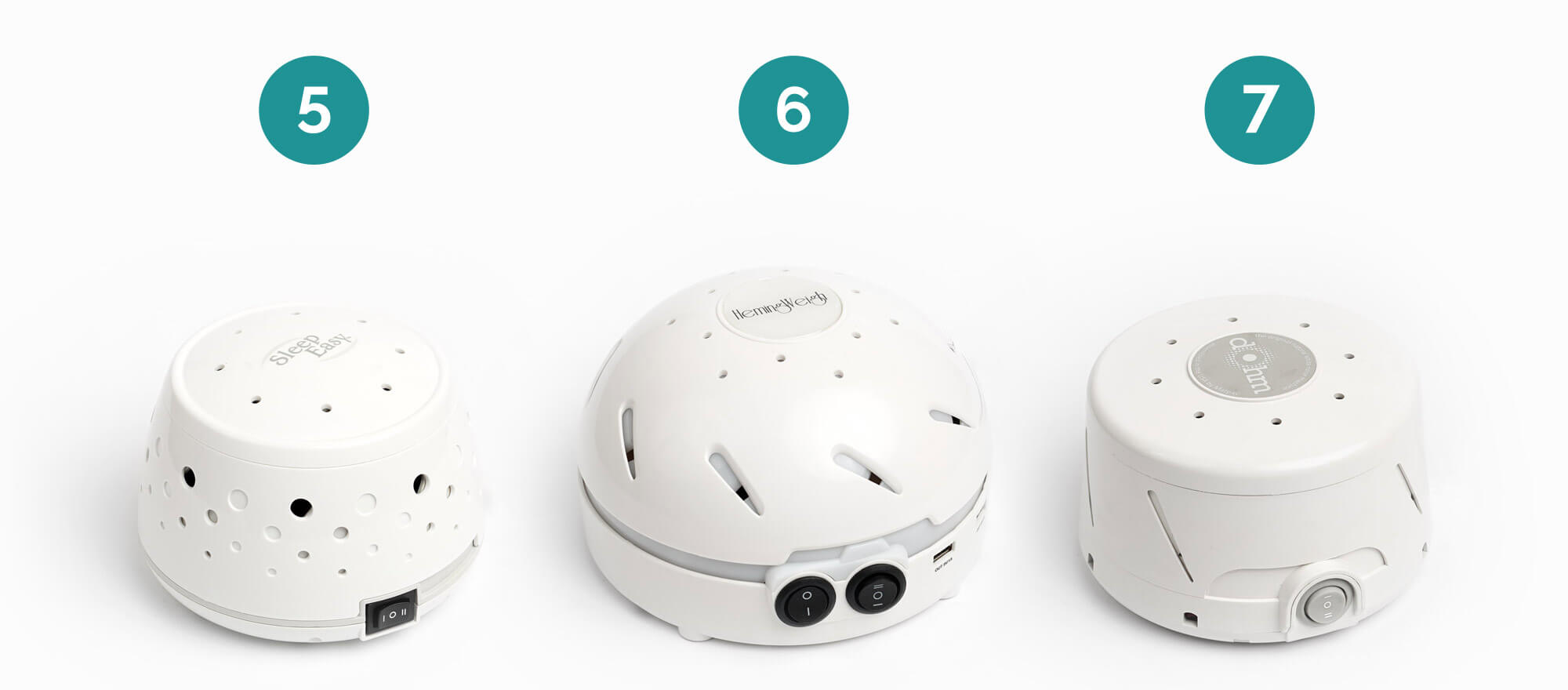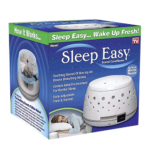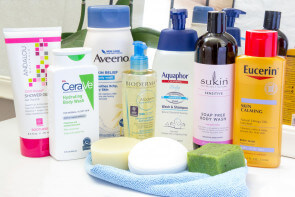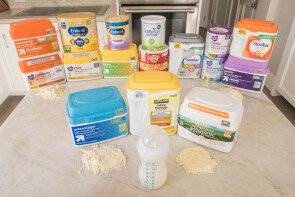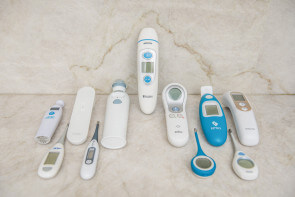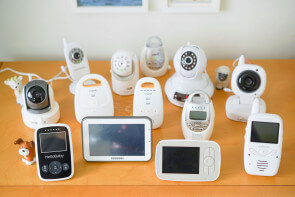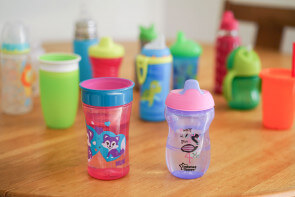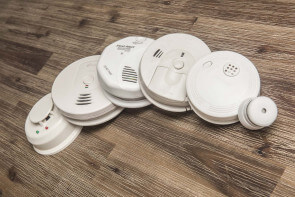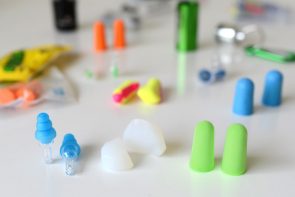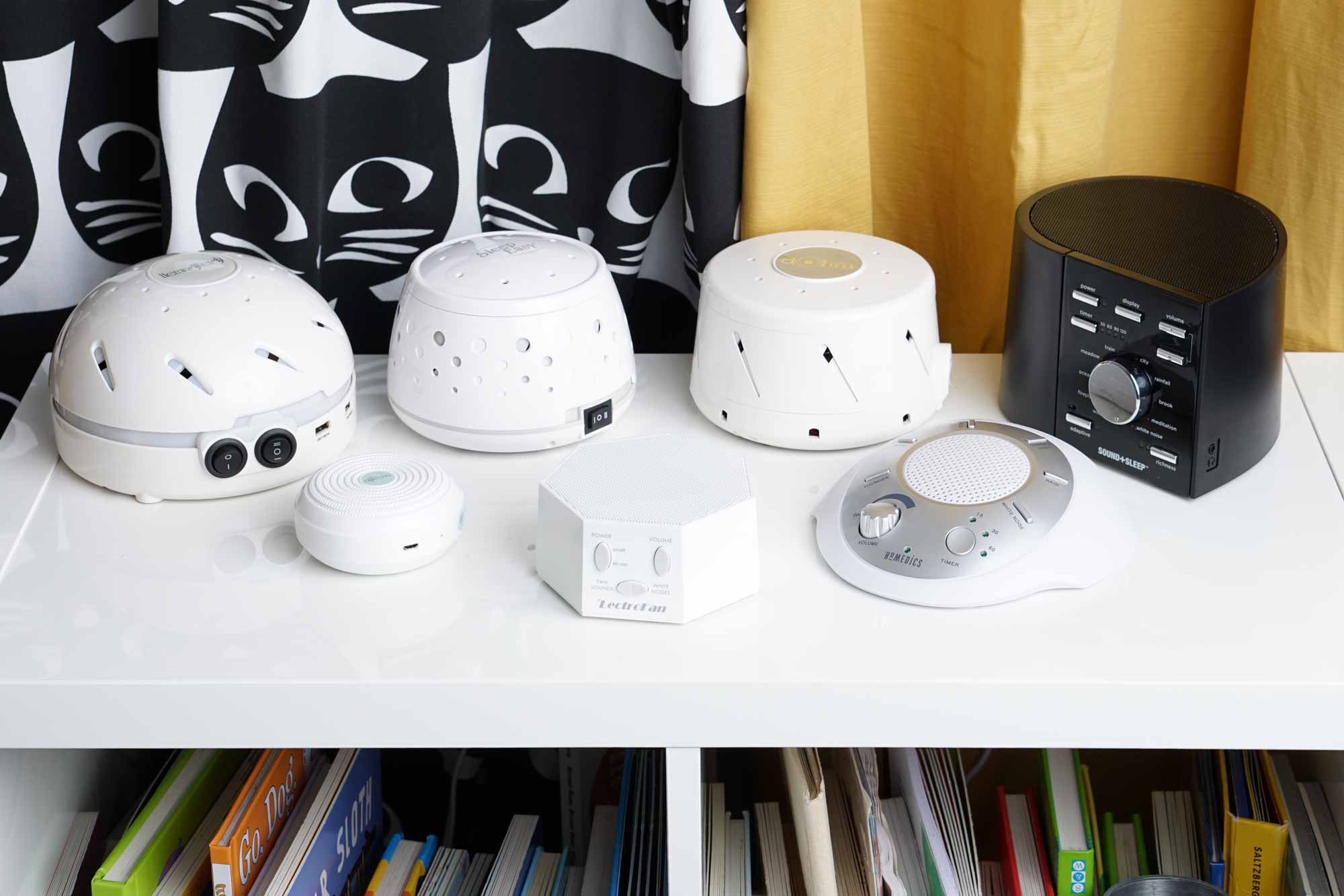
The 7 Best White Noise Machines
After giving each of seven top-rated white noise machines a full week of overnight sleep tests, running them through a daytime sound-masking bootcamp and finally giving each machine a thorough one-on-one going-over, we chose Adaptive Sound Technologies – ‘LectroFan as the best white noise machine. Unlike competitors, the compact ‘LectroFan offers a large variety of white noise and fan sounds, plus a wide range of volumes. For a portable option, we like the Marpac – Rohm.
After giving each of seven top-rated white noise machines a full week of overnight sleep tests, running them through a daytime sound-masking bootcamp and finally giving each machine a thorough one-on-one going-over, we chose Adaptive Sound Technologies – ‘LectroFan as the best white noise machine. Unlike competitors, the compact ‘LectroFan offers a large variety of white noise and fan sounds, plus a wide range of volumes. For a portable option, we like the Marpac – Rohm.
Table of contents
- The 7 white noise machines we tested
- 1. Best overall: ‘LectroFan
- 2. Best portable: Marpac – Rohm
- 3. Best analog: Sleep Easy
- Other products we tested
- How we selected
- How we tested
- Important features to consider
- The bottom line
The 7 white noise machines we tested
| Product | Price | Fan/Digital | Battery Option | Noise Masking Performance |
|---|---|---|---|---|
| 1. Adaptive Sound Technologies - ‘LectroFan | $$ | Digital | No | 4.5/5 |
| 2. Marpac - Rohm | $$ | Digital | Yes: 8 - 10 hrs | 4/5 |
| 3. Adaptive Sound Technologies - Sound+Sleep | $$$ | Digital | No | 4.5/5 |
| 4. HoMedics - Sound Spa | $ | Digital | Yes: 96 hrs | 3/5 |
| 5. Sleep Easy - Sound Conditioner | $$ | Fan | No | 2/5 |
| 6. HemingWeigh - White Noise Machine | $$ | Fan | No | 2/5 |
| 7. Marpac - Dohm | $$ | Fan | No | 2/5 |
1. Best overall: ‘LectroFan
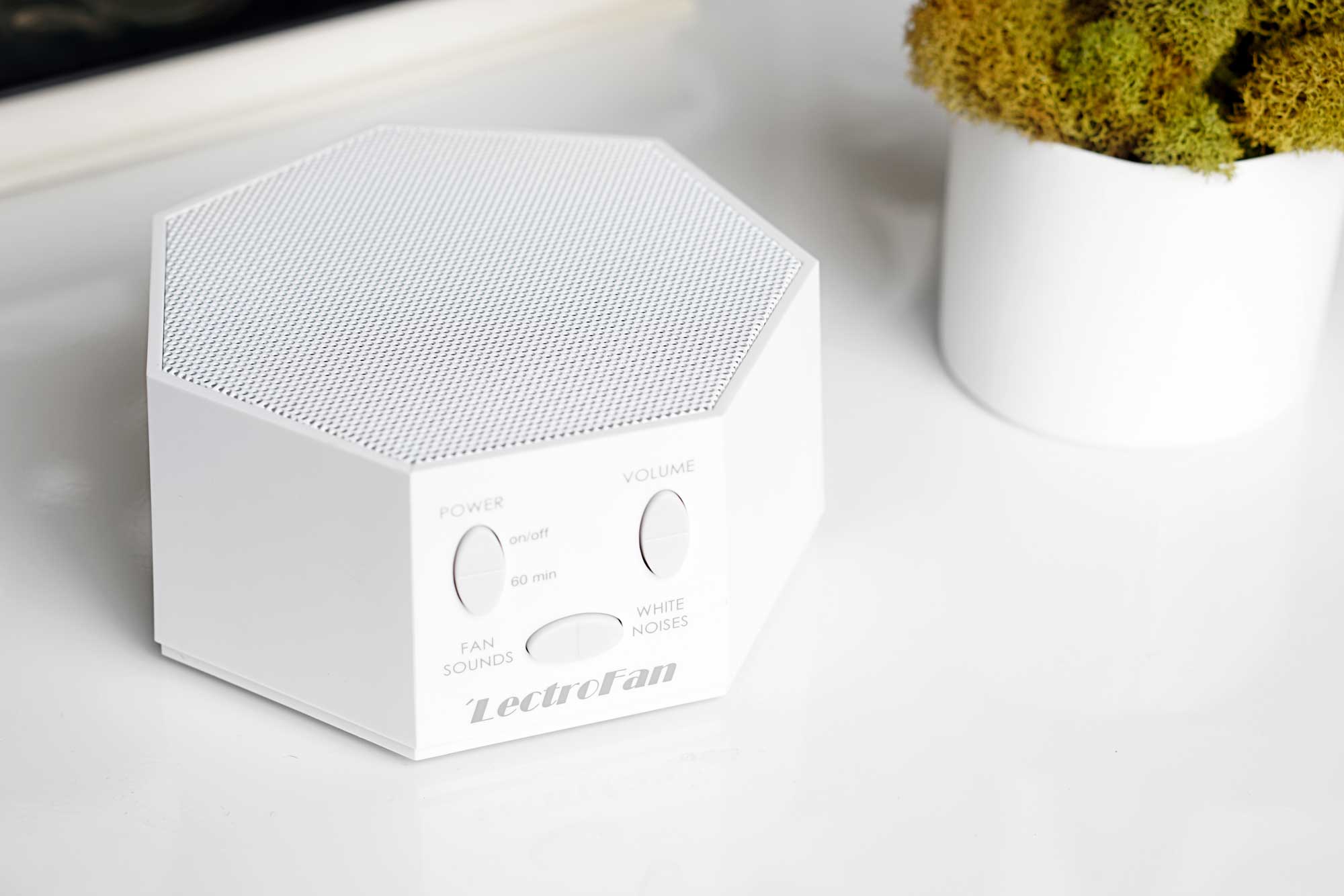
With the highest scores in nearly all of our tests, Adaptive Sound Technologies – ‘LectroFan is our choice for the best white noise machine. It’s the only machine we tested that offers a selection of white noise and fan sounds, in addition to being the only finalist to ace our sound masking tests. ‘LectroFan’s simple design and straightforward controls were great selling points for our testers, with no question about how to operate it or its purpose in the home.
The versatility of a white noise machine that offers a wide range of truly “meaningless” sounds is incredibly valuable. Most white noise machines offer only one or a few sounds to choose from, so you may need to purchase and return several machines before you find just the right one. ‘LectroFan offers 10 fan sounds, from box fan to industrial fan, and 10 white noise sounds, including “champagne” and “chestnut.” Our favorites? Vent fan for working, cinnamon noise for sleeping.
In our testing, ‘LectroFan’s loudest, most grating white noise and large fan sounds covered up all ambient noise and sound from an adjacent room, including the booming explosions of an action movie. As previously noted, you might not want to have this machine at full volume, but it does offer you the option to run it at high volumes in order to mask all kinds of environmental sounds.
In overnight tests, ‘LectroFan fit seamlessly in our testers’ nighttime routine. After finding the right white noise and the appropriate volume, our testers gladly used ‘LectroFan every night of its test week. With no display lights to brighten the sleeping area and a small footprint that didn’t take up much space on the tabletop, ‘LectroFan was a welcome addition to the bedroom.
Design-wise, ‘LectroFan is low-profile, geometrical, and inconspicuous. It’s available in black or white. At around $45, it’s a little more expensive than most of the other finalists, but a few days of use prove its worth. The nearly 5-foot cable allows the unit to be powered via a USB plug or the included A/C adaptor. The three rocker buttons are easy to manipulate even in the dark. The 60-minute timer can be pressed multiple times to add more hours. And to help you find your favorite white noise or fan sound as you’re scrolling through the options, a soft whoop sounds briefly at the beginning of the list. This is a smartly designed machine.
Key takeaways:
- ‘LectroFan has 10 fan sounds and 10 white noise sounds from soft and unobtrusive to harsh and grating.
- Volume range up to 85 dB to cover up the most stubborn environmental noise.
- Power via USB or included A/C adaptor.
- Use continuous play or set the timer in 60-minute increments.
2. Best portable: Marpac – Rohm

We updated this review for 2020!
For travel, baby stroller, or any other situation where you might not want (or be able) to plug in your white noise machine overnight, we recommend Marpac – Rohm. Two white noise settings with a good range of volume and a battery life of up to 12 hours make this white noise machine a winner.
At 3.5 inches in diameter and only 3.8 ounces, Rohm is the smallest white noise machine we tested. It charges via micro USB, so you won’t even need to pack an extra charging cable if you already have one for your phone — although one is provided with the unit. Rohm will operate while plugged in, as well as up to 12 hours (at middle volume in our testing) unplugged with a full charge of its lithium-ion battery. It can sit on a tabletop or other surface or can be hung by the included lanyard. After many years of usage, when we’ve forgotten to bring a charger, this battery still lasts all night and has never run out of power in the middle of the night! We love this white noise machine we even travel with it now–see it on our post on the best travel accessories.
Both the bright white noise and deep white noise settings are continuous; we could not detect a pattern of any kind during our overnight or practical tests. Our testers preferred the deep white noise for sleeping but found the bright white noise similar enough to accidentally use it one night without noticing. Each setting has a volume range adjustable to over 70 dB, and in our testing was enough to cover dogs barking, TV conversation and city noise.
It’s important to note again that the volume should be kept quite low if using in a baby’s crib, stroller, or car seat. Experts recommend setting it to about the volume of a bathroom shower to prevent hearing damage. That said, this is a great machine for use with babies especially because its portability allows you to provide a consistent sonic environment no matter where you take your little one. In fact, we have a friend with a newborn who has about four of these units placed around the house to help their child fall asleep.
Marpac also makes Hushh, which is marketed specifically for use with babies and is identical to Rohm except for a night light and a button lock.
We have a few minor gripes with Rohm: The unit comes with a micro USB cable, but no USB plug adapter. Chances are most people have a few of these around their homes, but at a price point over $30, we would expect such a convenience to be included. Secondly, when plugged in, you have to hold the power down for about three seconds before it powers on. When not plugged in, you have to hold it for about five seconds. The issue is that there’s no indicator letting you know it’s been long enough, and there is a pause before it powers on after you release your finger. This means sometimes you’ll need multiple attempts before successfully powering it on. We suspect this is a feature to prevent accidental power-ons.
Overall, though, we were pleasantly surprised by this tiny powerhouse. Rohm is a great choice for travelers, campers or anyone on the go who wants to take a little bit of home with them.
Key takeaways:
- Marpac – Rohm is small enough to fit in a carry-on, backpack, or purse, but also great for use at home.
- Charges via micro USB, but doesn’t include a USB plug adapter.
- Battery life of up to 12 hours on a full charge.
3. Best analog: Sleep Easy – Sound Conditioner
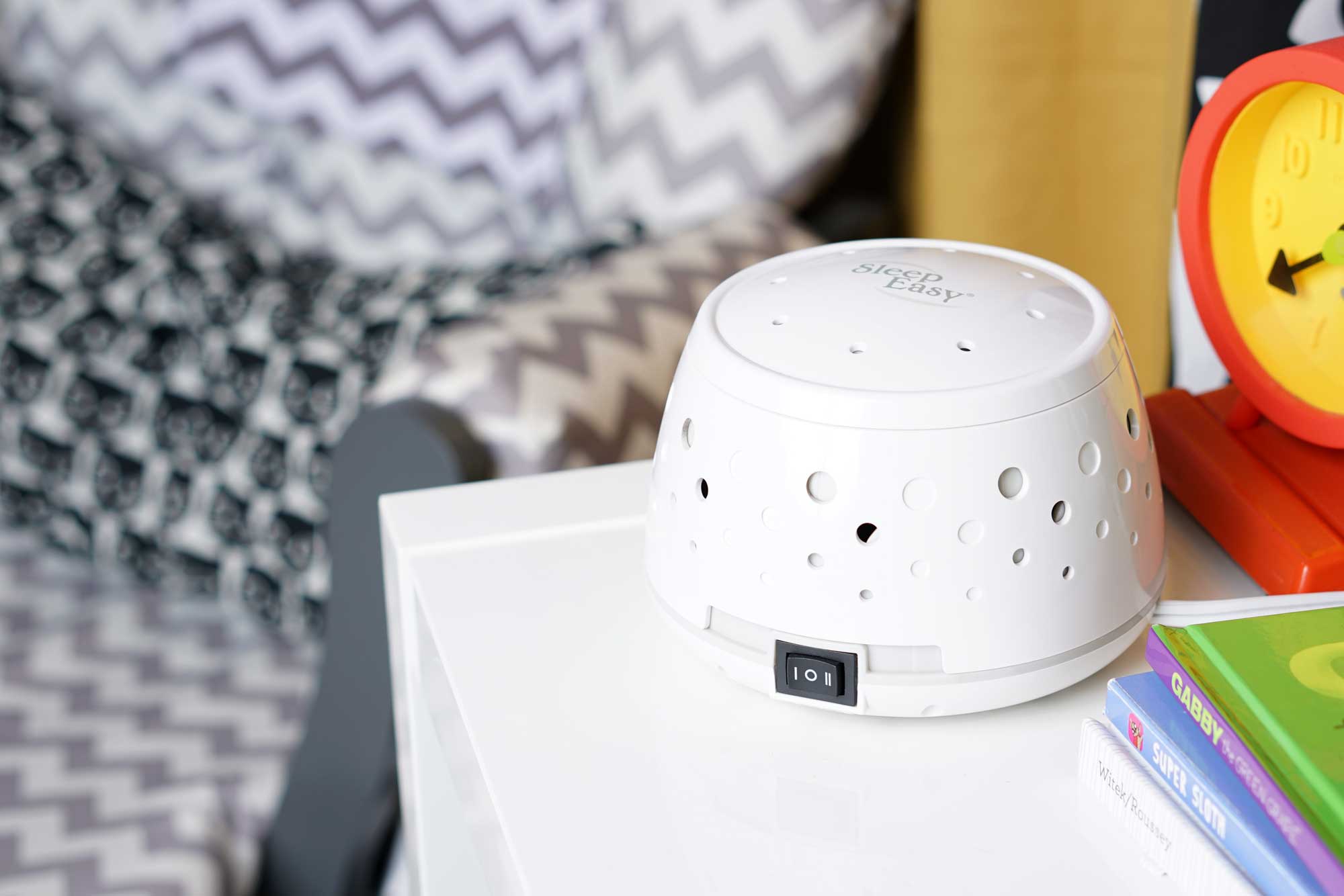
We were not blown away by the analog white noise machines. In a sleeping environment, our testers wanted a much louder white noise sound than any of the analog machines provided. Overall, in fact, the three analog machines we tested felt more or less interchangeable. They had the same control buttons and the same vented, rotating outer casings. The few extra features on HemingWeigh (see below) didn’t even set it apart to a significant degree.
It came down to sound. Two of the analog machines had a metallic whine or motor noise along with the fan sound that was mildly unpleasant. The one analog machine without the motor noise, Sleep Easy – Sound Conditioner, is our choice for the best analog white noise machine.
Sleep Easy is a machine that will probably need to live on your bedside table, rather than on a dresser or another surface across the room. The fan sound is quite low; on the highest setting, it’s only 62 dB, which is around the volume of conversational speech. But in a quiet room, the fan sound is especially soothing, and the faint stirring of the air that results from the fan itself is pleasant.
With a tan casing, circular side and top vents, and a black rocker on/off button, Sleep Easy looks a lot like the other two models we tested. However, at less than $30, it’s the least expensive model we tested, which may give it an additional edge over the competition.
This is definitely not a white noise machine for someone looking to mask environmental sounds in their bedroom. But in a quiet environment like a baby’s room or a typically quiet home, or for a sleeper with tinnitus, Sleep Easy is a good choice.
Key takeaways:
- Sleep Easy provides pleasant fan-created white noise without any motor sound.
- Highest setting around the volume of normal conversation (i.e. rather quiet).
- Best for use in a quiet setting or for sleepers with tinnitus.
Other products we tested
4. Adaptive Technologies – Sound+Sleep (digital)

Sound+Sleep from Adaptive Sound Technologies offers a quality white noise sound, a wide range of volume options, and a timer with four settings. Additionally, this machine includes an “adaptive mode,” which manufacturers say listens to your environment and adapts the sound machine to meet your specific needs.
Sound+Sleep is a rather large, sleek-looking tabletop white noise machine with a black casing, chrome buttons, and a large central chrome dial. At two pounds and nearly seven inches long, this teardrop-shaped machine is the heaviest and largest we tested. An A/C power adapter with a nearly 5-foot cable is included. Despite its relatively lightweight, this finalist feels substantial enough not to be especially portable. It’s not really made for travel. And at around $80, it’s the most expensive model we tested.
In our overnight tests, Sound+Sleep got high scores for its deep static white noise sound. Testers liked its volume range and noise masking ability, as well as its non-looping digital white noise. A “display” button that turns all display lights on and off was the testers’ favorite feature on Sound+Sleep. Overnight testers did note a kind of musical overtone to the white noise that was not unpleasant, but still noticeable.
In addition to Sound+Sleep’s white noise setting, there is nine soothing sounds (such as meadow and train) and a “richness” button that adds up to two levels of enrichment to each sound. As noted above, we did not test any soothing sounds in this review, focusing solely on the white noise options for each machine.
Adding richness to the white noise made it louder, harsher, and higher-pitched. Interestingly, adding richness in our noise masking tests made the sound less effective at masking environmental noises, even though the sound was louder. Our testers overwhelmingly preferred the white noise sound with no richness added.
The other unique feature of Sound+Sleep is its adaptive technology, which uses a built-in microphone to detect environmental sounds and then changes the sound accordingly. In our testing, this feature was not impressive. Rather than keeping the settings as you’ve chosen and adapting the sound from that point, the adaptive mode raises and lowers the volume of white noise to match environmental sound. So in a quiet room with occasional bursts of noise such as talking or children playing, Sound+Sleep lowers the volume to nearly undetectable and raises it occasionally when it “hears” a loud enough sound. In our overnight testing, the microphone wasn’t sensitive enough to pick up street noise from the window, so it kept the volume of white noise too low to be effective for sleep.
Overall, we liked the single no-richness-added white noise option and the display on/off button on Sound+Sleep. If you’re looking for several soothing sound options, this might be worth the time and money. But if you’re mostly looking for white noise, look at less expensive models to meet your needs.
5. HoMedics – Sound Spa (digital)
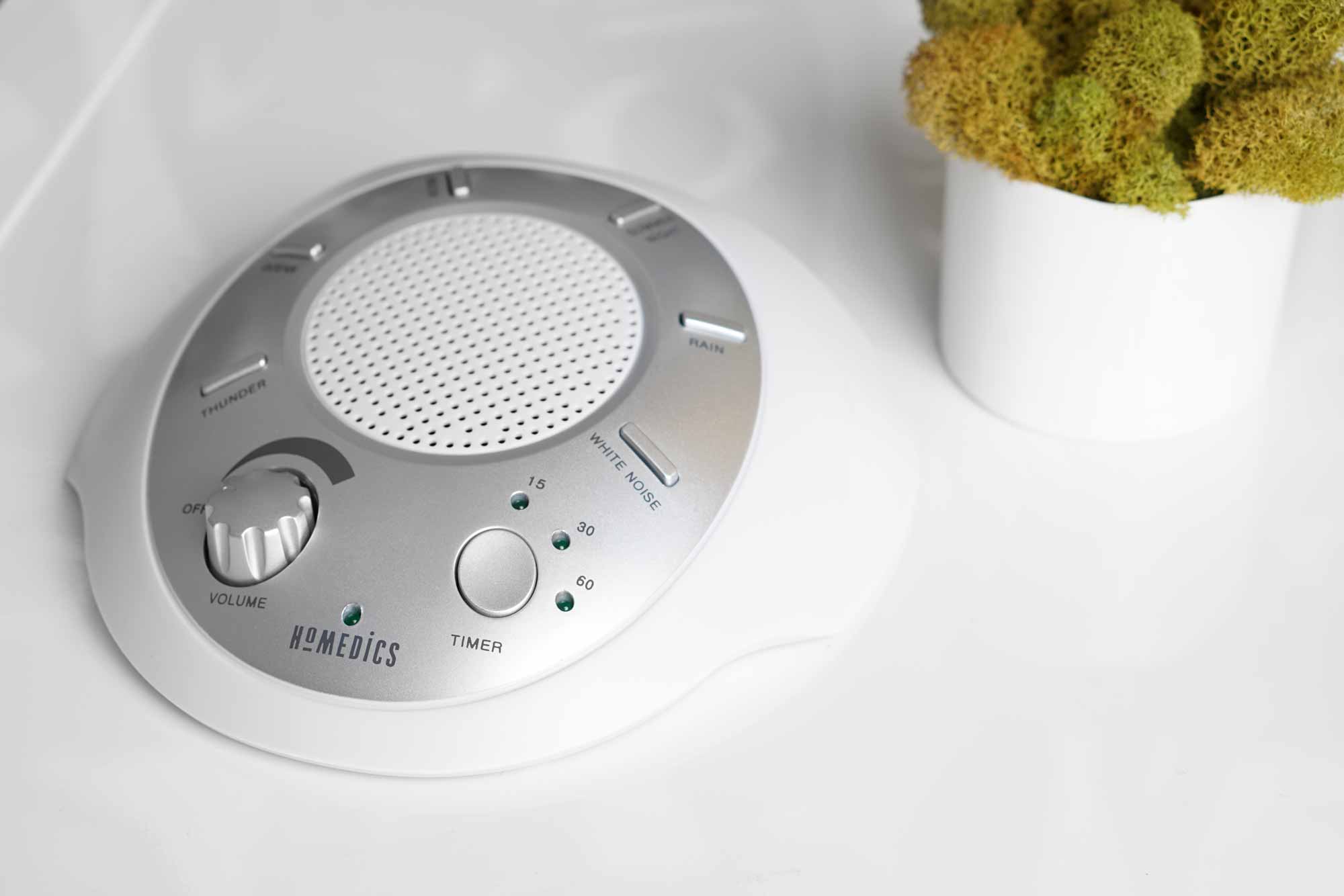
Sound Spa by HoMedics was our least favorite of the digital white noise machines we tested. The lightweight, low-profile machine has one white noise function (among five other soothing sounds), a three-setting timer, and a good volume range.
Weighing in at half a pound and not even two inches high, HoMedics is quite portable even with its 6.5-inch footprint. Made from very lightweight plastic, HoMedics feels rather cheaply made, but the buttons and volume dial are reassuringly responsive. The 6-foot A/C power adapter cable provides continuous power, or you can get about 100 hours of power at full volume from four AA batteries. At around $20, this was the least expensive white noise machine we tested.
The white noise option on HoMedics sounds harsh and thin compared to our top picks, a bit like a heavy rain with the warmer, deeper notes removed. Our overnight testers noted an unpleasant pulsing in the white noise sound and were annoyed that the display light could not be shut off. Testers abandoned this machine only a few hours into each night of its tests.
Overall, HoMedics is an inexpensive, portable option for consumers who aren’t especially picky about discernible patterns in their white noise.
6. Marpac – Dohm and HemingWeigh (analog)
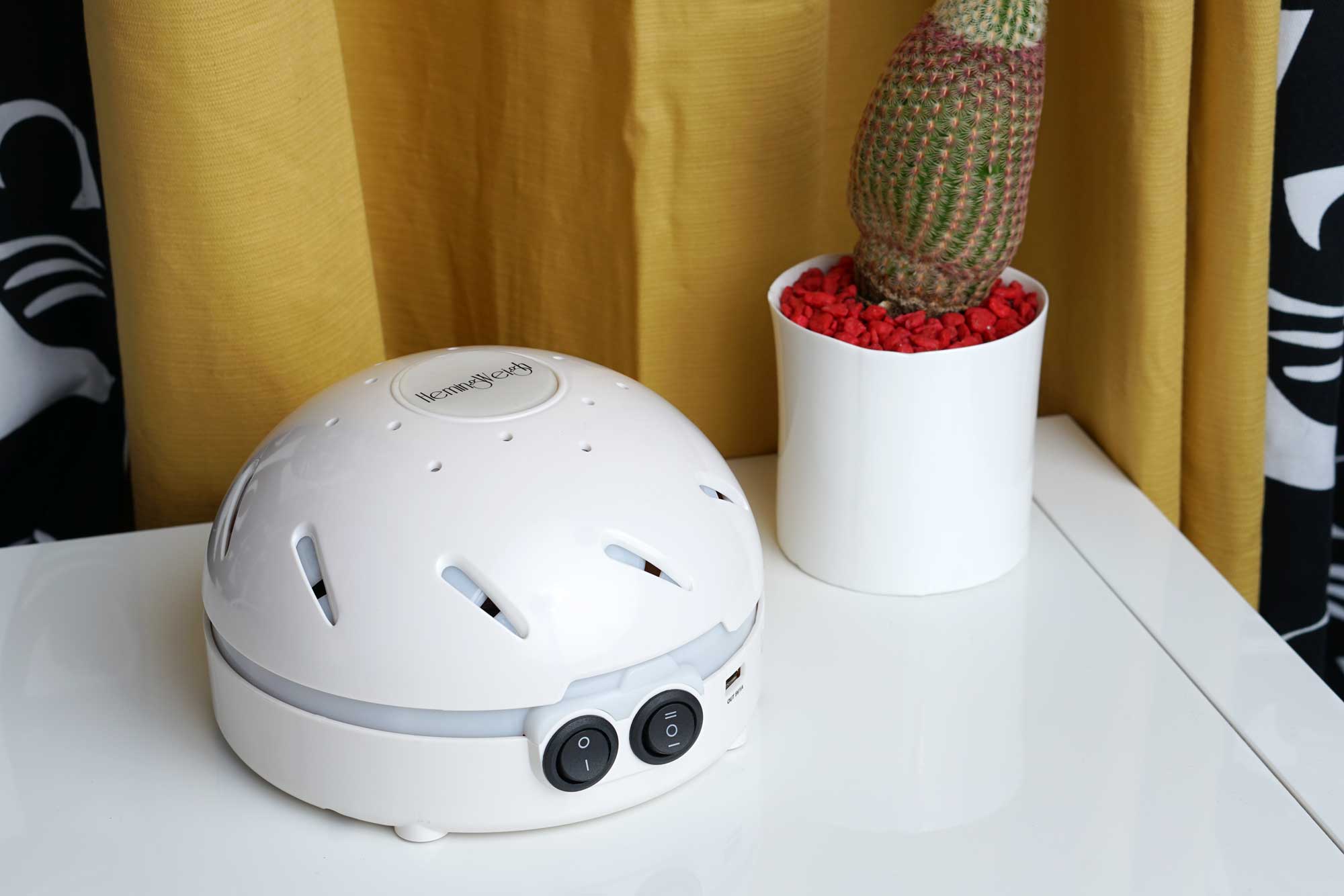
In almost every test, analog white noise machines Marpac – Dohm and HemingWeigh are indistinguishable. A couple of features set HemingWeigh apart, but sound-wise, they are remarkably similar.
They’re both off-white and dome-shaped, with angled vents on the sides, circular vents on top, and black rocker buttons on the front. Each creates its white noise sound with an internal fan, and both have a slight mechanical whirring that accompanies the fan sound. Additionally, they both have long power cables and top volumes of close to 60 dB in testing.
Their differences are few. HemingWeigh has a bright night light and two USB ports on its front, neither of which Dohm can boast. And price-wise, HemingWeigh is around $30 and Dohm is about $40.

All of that said, both HemingWeigh and Dohm provide innocuous fan-created white noise with no discernable patterns and an enjoyable light breeze that stirs the air immediately around the machine in a pleasant way. Neither was loud enough to pass any sound-masking tests or make it through an entire night for our overnight testers, but might be sufficient in a baby’s room or otherwise very quiet bedroom. Both are relatively lightweight and compact, so would likely travel well, especially HemingWeigh with its additional features.
How we selected
Before we began choosing white noise machines, we did a crash course in the science of white noise and its benefits. Articles at Popular Science, How Stuff Works, and Pacific Standard gave us a good background on types of noise — white and otherwise — as well as why it works to assist sleep and mask sound.
Next, we looked at some blogs that specialize in improving sleep quality, and read their recommendations for white noise machines. The review Sleep Like the Dead was especially informative. Finally, we headed over to Amazon to select our finalists from among the highest-rated and most-reviewed white noise machines.
Many of the experts cited in our initial research noted the important difference between white noise and soothing sounds, such as ocean waves or babbling brooks. Although digitally sampled or simulated sounds like flowing water or wind chimes can be calming, they can also be distracting by causing the mind’s attention to jump from one aspect of the sound to another. Plain, ordinary white noise — the more boring, the better — is the best choice for better sleep, noise-masking, and concentration. For this reason, we selected finalists that offered white noise and fan sounds and chose not to review any additional “soothing sounds” that might be included on a given machine.
How we tested

Our group of seven white noise machine finalists included three analog machines and four digital machines. We tested only the “white noise” and “fan” functions of each machine, ignoring any other sound options like waterfalls and ocean waves.
Pushing the buttons
Each of the three analog machines we tested — HemingWeigh, Sleep Easy and Dohm — has a power switch and a single rocker switch to select low or high fan. (HemingWeigh has one additional button for the nightlight function.) In addition to buttons, the analog machines each feature an adjustable outer casing with slanted and circular vents in various sizes. Rotating the casing changes the airflow through the vents, affecting the quality and volume of sound produced.
The digital machines had more button options. ‘LectroFan has three rocker switches to control power, volume, timer and sound options. Rohm has four pushbuttons for power, volume, and sound options. And Sound+Sleep and HoMedics each have a single dial and seven push buttons for sound options, timer, and other functions.
We spent a couple of hours running through the range of white noise and fan sounds and their volumes on each machine. We made sure the timers were true and the buttons did what they were supposed to do.
Finally, we cranked each white noise and fan sound on each machine up to its highest possible volume and used a sound meter to measure the amplitude.
Practical testing
We conducted our practical testing in two parts. First, we measured how well each finalist masked sounds in an adjacent room. Then, we used each machine overnight for a week to see how it affected our testers’ sleep.
Masking household noise

Chances are, if you live with a spouse, roommate, child, or pet, there are times they make noise when you’re trying to sleep. White noise machines can help to cover up the sounds in rooms adjacent to your bedroom and keep noise-related domestic disturbances to a minimum.
With our white noise machines set up in a quiet room, we used a stereo system to play recorded sounds in an adjacent room. We mimicked the experience of overhearing a variety of common household distractions, such as dogs barking and a TV sitcom playing, then used a sound meter to measure how well each machine covered up the sounds.
On the whole, none of the white noise machine finalists were overwhelmingly successful at masking noises in an adjacent room, but some were better than others. All of the digital machines, for example, were louder than any of the analog machines, and therefore much better at covering sound.
It’s important to note that white noise can be very grating and inhibit sleep at high volumes. Having a white noise machine that can mask noises at very high volume doesn’t necessarily make it the best. However, having the option to make it louder makes it a more versatile machine, which we think does generally make it better.
Overnight test
Each machine was placed in the same location in the bedroom roughly two feet from the foot of the bed, display facing the bed and speaker facing the ceiling. Sleepers spent some time before bedtime running through the settings to find the right sound and turning the volume to the appropriate level.
In overnight tests, our testers overwhelmingly favored the digital machines. The analog machines were simply not loud enough to provide enough sound for a soothing effect. Even when moved directly next to the head of the bed, the analog machines were not loud enough for our testers, although they did note a pleasant stirring of the air that was soothing.
Besides volume, other complaints included display lights that couldn’t be turned off and too harsh white-noise sounds. Testers also noted that some of the finalists’ power cables were quite short, which wasn’t a problem in our testing room, but certainly could be in a hotel room or other non-home situation.
For our testers, who were already used to sleeping with white noise, there was no marked improvement in sleep with any of the machines. However, there were more uneasy nights with some of the finalists, most notably the analog machines, which were too quiet to assist with sleep.
Portability
As the only rechargeable white noise machine we tested, Marpac – Rohm takes top honors for portability with its 12 hours of cordless operation.
HoMedics – Sound Spa can run on an included power cable or four AA batteries, which makes it portable as well, although it is larger than Rohm. Every other machine we tested must be plugged in to work. Moving any of them from one location to another within the same house is no problem at all, and none of the units we tested will take up too much room in a suitcase. However, at two pounds, Sound+Sleep is the heaviest white noise machine we tested and the only one we would consider too heavy to call portable.
Battery life
Rohm and HoMedics are the only white noise machines we tested that have a battery option. Rohm has an internal lithium-ion battery, rechargeable via an included USB cable. HoMedics can be powered either by its wall adapter or by four AA batteries.
When Rohm was fully charged, its battery life was between 10 and 12 hours. And at full volume, starting with new batteries, HoMedics gave around 100 hours of operation.
Price
As with most electronics, the simpler units are less expensive and the machines with more bells and whistles cost more. The least expensive white noise machine we tested, HoMedics (around $20), looks rather cheaply made but doesn’t feel flimsy or poorly constructed and the audio is decent quality. Sound+Sleep (around $80) costs four times more than HoMedics and looks and feels substantial, well-designed, and is jam-packed with sound options, although not much in the way of white noise.
The three analog machines we tested each cost around $30 (Dohm is a little more) and feel mostly interchangeable regarding materials, construction and performance. And our two top finalists, ‘LectroFan (around $45) and Rohm (around $35), each feels well-made but not over-engineered, with no extra buttons or features that could increase their prices.
What is white noise and how does it help?
Research suggests that white noise can improve sleep quality, ensure your private conversations aren’t overheard, and even enhance your ability to learn. Many parents also use white noise to help their babies sleep better and longer.
White noise is made up of all the frequencies a human ear can hear, sounded all at once. The term white noise is a comparison to white light, which is a combination of all the frequencies of light the human eye can see. At its purest, white noise sounds like a rather high-pitched radio static.
Frequency: The height of the wave, or the pitch of a sound, measured in hertz (Hz). For example, middle C on a piano is around 261.6 Hz. A healthy human ear can hear from around 20 Hz to 20 kHz (20,000 Hz). You might feel, more than hear, a very low bass tone at 20 Hz. The human voice is generally between 1.6 and 4 kHz. Electrical devices can emit high-pitched whines above 16 kHz, toward the top range of human hearing. Dog whistles usually start around 23 kHz.
Amplitude: The force of the wave, or the volume of a sound, measured in decibels (dB). The human ear can hear sounds beginning just above 0 dB, and can be irreparably damaged when exposed to sounds as high as 160 dB. A human whisper is around 20 dB and normal speaking volume is around 60 dB. Traffic noise is about 85 dB; exposure to prolonged noise louder than that for extended periods of time can cause hearing damage without ear protection. Jackhammers and ambulances are around 120 dB.
Combining all audible frequencies at equal amplitude into one sound can have the effect of canceling out or covering up ambient sounds. Other “shades” of white noise, such as brown noise or pink noise, use a similar frequency-combining technique, but with certain frequencies played at higher amplitude in order to cover up more specific ranges of sound. A quick YouTube search yields samples of each different shade of white noise.
For purposes of simplicity in our testing, we’re using the term “white noise” to apply to any white noise or fan setting on one of our white noise machines, using descriptive language rather than other “colors” to describe differences in tone.
Better sleep

Sleeping difficulties can be caused by a number of factors, including street noise, stress, sleep partner noises, and tinnitus. While white noise can’t cure all sleep problems, research suggests it can improve sleep in the average bedroom and especially in noisy or disruptive environments, including the ICU.
There are many explanations for how white noise works. Some experts say that white noise blocks out sudden changes or inconsistencies in the sleep environment that could wake you up. Others suggest that the combination of so many frequencies limits the brain’s ability to pick out a single sound among the many, effectively masking any unwanted environmental sounds.
No matter how it works, many people use white noise to help improve sleep. People with tinnitus, or ringing in their ears, can find it helpful to play a low-volume white noise to distract from the sound in their head. White noise can cover up the snores of a roommate or the street noise coming in your bedroom window. And as some meditation practitioners advocate, low-level meaningless noise can help a person clear their mind of stresses and worries in order to relax.
Fewer distractions and more privacy
White noise is not sound cancellation — that is, white noise doesn’t work by minimizing or eliminating sound waves. Businesses with open-concept work environments sometimes use sound cancellation systems to minimize workers’ ability to overhear each other.
But personal white noise machines can be effective for covering distracting environmental sounds or private conversations. In the same way, white noise can mask the sound of snores or street noise, it can cover voices from an adjacent conference room or doctor’s examination room.
Better learning
Using white noise can help improve learning. Studies have shown that white noise can help with memory and fact recall, and improve information processing. It’s also effective for improving memory difficulties related to aging.
Why babies love white noise
White noise can mimic the sounds a baby hears in the womb — the muffled jumble of voices, the whooshing of mom’s heartbeat, the vague rumble of environmental noises. Using white noise in a baby’s room can replicate this environment and the feelings of safety and comfort it triggers. The shush sound that people instinctively use to soothe a crying baby is a kind of white noise. Placing white noise in a baby’s sleep area can promote deeper and better quality sleep.
Experts caution parents not to place noise machines too close to the baby’s head, however. White noise should be around 50 dB, or about as loud as a bathroom shower, to prevent damage to a baby’s ears.
Important features to consider

Personal tastes vary a lot regarding sleep environment, but there are some common features to look out for when shopping for a white noise machine.
No audible break or patterns in sound loop: White noise machines run for long periods of time, and any recognizable pattern or obvious break in the sound can be disruptive. Some digital white noise machines simply playback a recorded loop of noise that can have subtle patterns that become noticeable throughout the listening period. Noticing an obvious end and beginning in the loop or recognizing a pattern in the noise can be distracting enough to interfere with sleep or concentration.
Adjustable volume: Most bedrooms or workspaces won’t have the same level of sound every single day. Being able to adjust the volume of white noise can help mask unwanted sounds no matter how the environment changes.
Variety of sounds: It can be hard to know just what you’re looking for in a white noise machine until you try it out. A machine with a wide range of sound options can increase your chances of finding the perfect white noise for your needs.
Compact and portable: Humans are creatures of habit. Once we find our ideal environment, we want to duplicate it as easily as possible when we’re away from home. A white noise machine that can be easily packed in a suitcase or overnight bag can make a hotel room or vacation rental much more restful.
Reasonably priced: White noise machines can be viewed as investments in better living, but that doesn’t mean folks want to pay very much for one. The seven machines we tested range in price from around $20 to around $80.
Digital vs. analog: Analog white noise machines use fan-produced sound with an adjustable outer casing for fine-tuning pitch and volume. Digital white noise machines offer a greater range of volumes and an infinite variety of sounds. Analog machines tend to be quieter, but some people prefer the more natural sound of a fan over digitally produced or sampled sounds. However, normal wear and tear can cause fans to develop patterns or tics over time.
Design: Round, oval, heptagonal, tear-drop-shaped. Tall, low-profile, hangable. Push-buttons, dials. Display lights, no lights, adjustable lights. Portable, stay-put-heavy. Black, white, tan, chrome-accented. Some white noise machines are designed for utility, some have had obvious effort put into their appearance. In general, we made sure the design did not influence our ranking of the machine’s abilities.
The bottom line
With its large variety of white noise and fan sounds, compact design, and reasonable price tag, Adaptive Sound Technologies – ‘LectroFan is our top choice for the best white noise machine. For studying, sleeping, a baby’s room, or noise-masking, ‘LectroFan is a smartly designed, high-quality choice. If you’re looking for a compact, portable, cordless option, Marpac – Rohm is our recommendation. And if you crave the soothing sounds of a fan-produced analog white noise, Sleep Easy is our pick for you.
More Reviews
The Best Soaps for Sensitive Skin
CeraVe - Hydrating Body Wash
Parent's Choice
The Best Digital Thermometers for Babies and Kids
iProven - DMT-511
JuJuBe - B.F.F.
Contours - Options Elite
Britax - B-Safe Ultra
LÍLLÉbaby - Complete All Seasons
Infant Optics - DXR-8
Nuk - Magic 360
The Best Pillows for Side Sleepers
Coop Home Goods - Eden
First Alert - SCO501CN
Moldex - Pura-Fit


